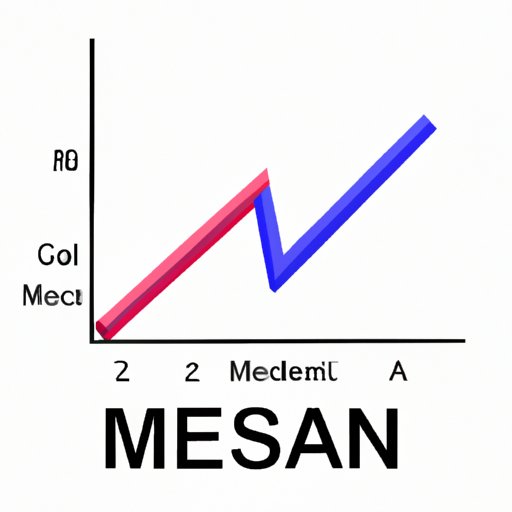Introduction
Finding the mean is one of the most common techniques used in statistics. It is an essential part of analyzing data as it helps to determine a data set’s central tendency. Knowing how to find the mean is critical in fields such as finance, economics, and even sports analysis. In this article, we will discuss the significance of finding the mean, step-by-step instructions for calculating it, real-world examples of finding the mean, and tips to avoid common mistakes.
Why Finding the Mean is Important
The mean is a measure of the central tendency of a set of numbers. It is calculated by adding all the numbers and dividing the sum by the total number of elements in the set. Mean is used to summarize a large dataset into a single value that represents the entire data set. This value is useful for a variety of statistical analyses, including trend analysis, forecasting, and hypothesis testing.
Finding the mean also helps in determining the relationship between variables in a data set. For instance, mean is used in finance to analyze stock prices. Similarly, mean is used in economics to analyze inflation rates. The mean value tells us the direction and intensity of changes in such variables over time.
In addition, the mean value helps in measuring central tendency. This statistical term is used to describe the typical or average value of a set of numbers. It helps to understand how a group of numbers cluster around a central value. The mean measures central tendency by representing the average of all values in the data set.
Step-by-Step Instructions on How to Find the Mean
Finding the mean is a straightforward process that can be accomplished in a few easy steps. Follow the steps below to calculate the mean of a given set of numbers:
Step 1: Add the set of numbers together.
Step 2: Count the total number of elements or observations in the given set.
Step 3: Divide the sum of the numbers by the number of observations.
Step 4: Voila! You have found the mean.
For example, suppose that you have a dataset containing the following numbers: 5, 7, 10, 12, and 20.
– To find the mean, you would add these numbers:
5 + 7 + 10 + 12 + 20 = 54.
– Next, count the total number of elements in the dataset:
There are five numbers in this set.
– Finally, divide the sum of numbers by the total number of elements:
54 / 5 = 10.8.
– Therefore, the mean of this dataset is 10.8.
Real-World Examples of Finding the Mean
Finding the mean is not just a theoretical concept – it is an essential tool in everyday life. Here are a few examples of how finding the mean is used in practical situations:
1. Grade Calculation: Mean is commonly used by teachers to calculate grades. This helps them determine how students are performing on a particular assignment or subject. By calculating the mean value, teachers can quickly assess the average performance of their students and identify areas where specific students are struggling.
2. Temperature Analysis: Mean is used by meteorologists to analyze temperature patterns in a specific region. This helps them predict future weather conditions and plan their operations accordingly.
3. Average Household Income: Mean is used by policymakers to analyze the income levels of people living in different regions. It helps them identify the average income of a particular region, which can be used for budgeting and planning purposes.
Mean vs Median: When to Use Each Statistic
While mean is a popular measure of central tendency, there are situations where it may not be the most appropriate statistic. For example, skewed data or datasets with outliers may not provide an accurate representation of the data set’s central tendency when using mean. In such cases, median is a more suitable measure of central tendency. Median represents the middle value in a data set, and it is not affected by extreme values or outliers.
To determine which statistic to use, it is essential to consider the type of dataset being analyzed. For normally distributed data sets with no significant outliers, mean is a suitable measure of central tendency. However, for data sets with skewed distributions or outliers, median may provide a more representative measure of central tendency.
Tips for Checking Your Work When Finding the Mean
To ensure that you have calculated the mean accurately, it is essential to double-check your calculations and cross-reference data points. Here are some tips to help you check your work:
– Use a calculator to recheck your calculations.
– Compare your results with the estimated mean computed in your head.
– Review the dataset and make sure all numbers have been included in the calculation
– Work with other people to ensure that calculations have been done correctly.
Common Mistakes People Make When Finding the Mean
Despite the simplicity of calculating the mean, many mistakes can be made. The most common mistakes made when finding the mean include:
– Failing to include all elements of the data set in the calculation
– Using the incorrect formula when calculated the mean of a dataset
– Misinterpreting the data set by using the wrong statistical measure
– Failing to account for negative numbers in the data set
To avoid these common mistakes, be sure to double-check your work and thoroughly review the steps in the calculation.
Conclusion
Finding the mean is a fundamental concept in statistics that plays a crucial role in analyzing data. It is a quick and easy way to understand the central tendency of a given dataset, making it an essential skill for anyone who works with numerical data. By following the step-by-step instructions, you can become proficient with calculating the mean and determine how to use it effectively in different contexts. Whether you are calculating stock prices or tracking weather patterns, the mean remains an essential statistical tool.
